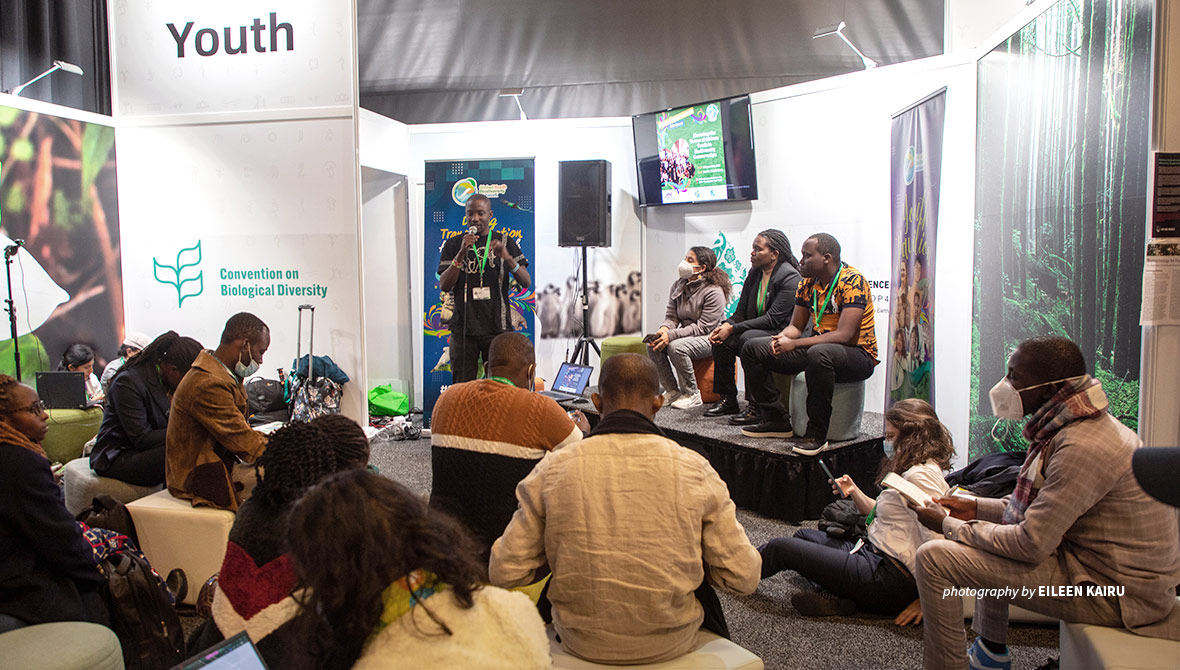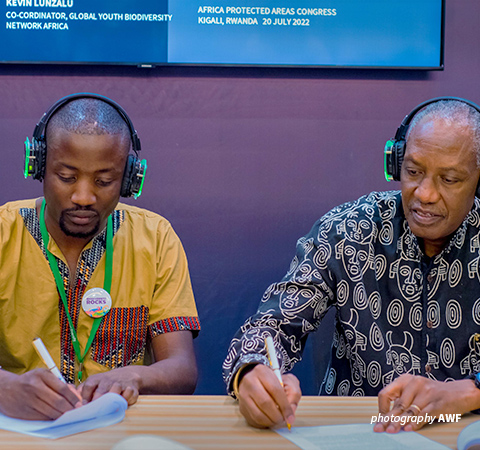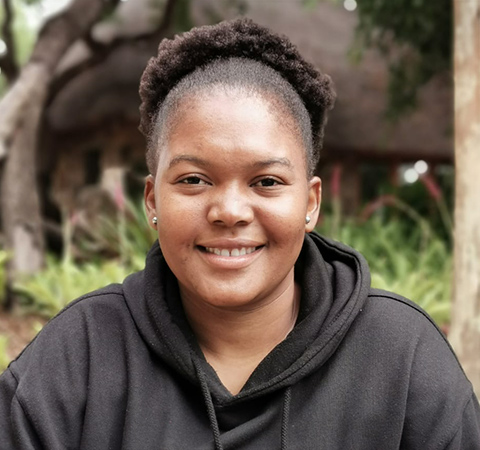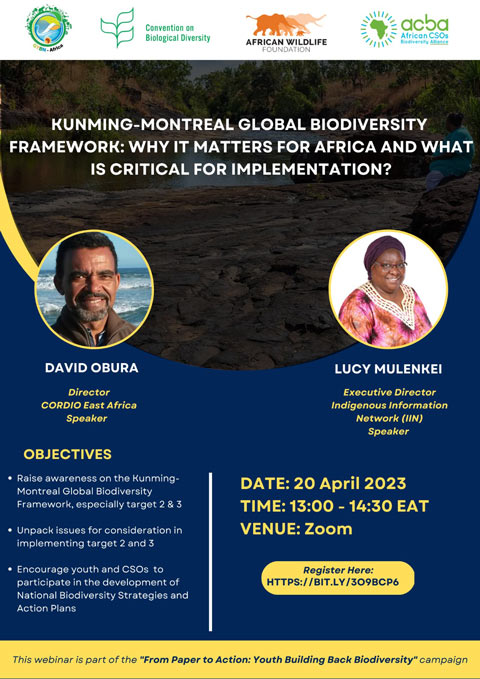Campaign rallies young Africans to implement biodiversity framework

Kenyan Youth Biodiversity Network Co-Founder Kevin Lunzalu addresses youth participants at the 15th meeting of the Convention on Biological Diversity in December 2022
Four months after the adoption of the Kunming-Montreal Global Biodiversity Framework (GBF), the questions are blaring. What happens next? How are we ensuring that we do not replicate the mistake of past multilateral agreements?
A unique aspect of this framework is that the youth were determined to contribute to the negotiations and start the implementation process early. The finance hurdle is yet to be tackled, but African youth have decided to take the bull by the horns and integrate the framework within their existing spaces and projects. In this piece, we feature two like-minded African youth of the ‘From Paper to Action: Youth Building Back Biodiversity’ campaign.
The campaign aims to inspire grassroots actions and create youth-based awareness on the outcomes of the 15th meeting of the Convention on Biological Diversity (CBD COP15). Kevin Lunzalu and Rerani Ramaano are members of the African Youth Biodiversity Network, the continental chapter of the Global Youth Biodiversity Network (GYBN), which has been working closely with the African Wildlife Foundation (AWF) to increase youth representation in CBD meetings.
AWF’s relationship with GYBN dates back to 2018, when the organizations jointly facilitated the African Youth Capacity-building workshop that led to the formation of several African chapters of the network. Further, our partnership with GYBN-Africa was cemented in July 2022 by signing a five-year partnership Memorandum of Understanding during the inaugural IUCN African Protected Areas Congress.

Kevin Lunzalu (left) and AWF CEO Kaddu Sebunya sign the Memorandum of Understanding in July 2022
Kevin Lunzalu, Co-Founder, Kenyan Youth Biodiversity Network
Kevin joined GYBN in 2017 after the Johannesburg global youth capacity building workshop and has been actively involved in building the Kenyan chapter, which has grown organically to become one of the largest and most vibrant GYBN chapters. In December 2022, GYBN Africa sent the largest-ever African youth delegation to COP 15, held in Montreal, Canada, with a dedicated exhibition booth and a youth pavilion where youth-led and youth-focused events were held throughout the convention period. Additionally, the Kenyan chapter was part of the key stakeholders invited by the government to a dissemination forum to discuss and internalize the decisions adopted during COP15 and Meetings of the Parties.
GYBN Africa remains committed to leveraging the campaign to engage as many young people as possible from across the continent, in English and French, and inspire grassroots action that will create a significant difference between the failed Aichi targets and the Kunming-Montreal Global Biodiversity Framework. Individual chapters across Africa are also working hard to implement on-ground projects that contribute to the adopted targets, such as ecosystem restoration, climate change, pollution, youth engagement, and capacity-building.
“The Kunming-Montreal Biodiversity Framework provides a unique opportunity for civil society, governments, private sector, and other stakeholders to deliberately engage young people in driving the development aspirations of Africa through models that benefit people and nature,” Lunzalu reiterated.
Several experts, including Lunzalu, agree that the Kunming-Montreal framework will only be successful if we deeply appreciate the role of young people in its transformation agenda.
“African youth are cautious of development models that are copy-pasted from systems and regions that progressed at the expense of natural resources. We must define transformative pathways that ensure development goes hand in hand with conservation.”

Rerani Ramaano is a member of the South Africa Youth Biodiversity Network
Rerani Ramaano, Project Coordinator, South Africa Youth Biodiversity Network
Rerani Ramaano is a young African conservationist passionate about biodiversity conservation in Africa and is part of the dynamic team running the Global Biodiversity Framework African youth campaign. She shared her reflections and aspirations guided by the newly adopted framework.
How did you get to know and join GYBN?
My journey with GYBN started in 2019 back in university through my very close friend who was and still is an active member of GYBN. It started through spending time with her and listening to her conversations with other young people about the CBD and the post-2020 GBF on how to rally more youth voices and promote youth involvement in nature conservation. It was then that I started asking more questions about what the framework was and all about the CBD. Lucky for me, at the time, the South African chapter of GYBN, the South African Youth Biodiversity Network (SAYBN), was planning youth consultation meetings on the framework, and that was my chance to jump in and learn more.
Have the COPs successfully created opportunities for youth in the landscapes to scale up their work?
After attending my first COP meeting in Montreal, Canada last December and seeing many young people in the space having their voices and opinion heard, I can confidently say that the COP is indeed creating opportunities for young people to thrive in the conservation space. I must acknowledge one of the newly added targets, Target 22 on the engagement of IPLCs, youth, and women. This inclusion speaks volumes about the opportunities young people have to influence the conservation space. With the increase in recognition of youth as important stakeholders in high-level negotiation processes such as CBD COP 15, it is essential not to lose sight of youth-led actions and grassroots projects that ensure youth continue to be changemakers not just at a policy level but in project implementation as well.

Where do you envision Africa in the next 10 years?
I envision a continent dedicated to conserving its biodiversity, respecting the rights of indigenous peoples and communities, and with young people at the forefront of conservation efforts. To achieve this goal, I firmly believe that Africa needs to focus on solving localized problems by not condoning development that harms natural resources.
The ‘From Paper to Action: Youth Building Back Biodiversity’ Campaign is currently running across all partner socials, GYBN Africa, African CSOs Biodiversity Alliance (ACBA), and AWF. We aim to cut through the policy jargon and present bite-size, simple information easily consumed by the public through infographics, explainer blogs, video testimonials, and webinars. The next webinar is set to take place on April 20, 2022, debunking why the framework matters for Africa with key experts who are part of vital working groups to the CBD part of the dialogue.